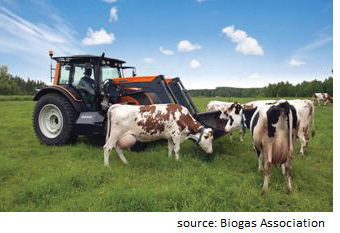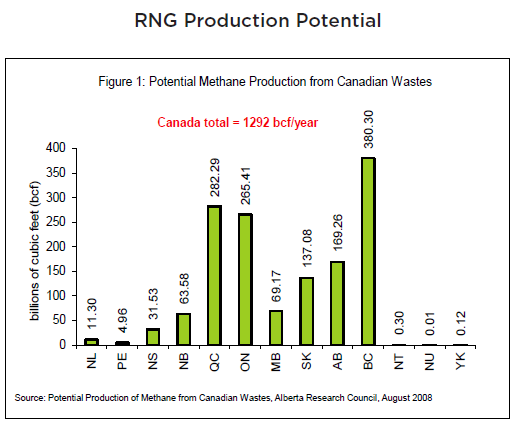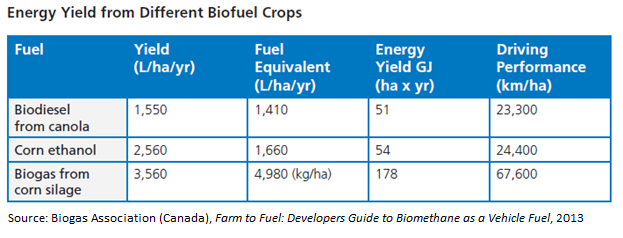The Canadian Gas Association, a leading industry trade group, issued a report in December 2014 promoting renewable natural gas in Canada. Titled, “Renewable Natural Gas Technology Roadmap for Canada,” the report offers very aggressive support for biomethane production as a means to both reduce waste and greenhouse gases while developing an underutilized renewable resource.
According the CGA’s report, there is an estimated 1,300 billion cubic feet of RNG supply potential available in Canada, which is equal to 50% of Canada’s natural gas consumption in 2012. While not all of the potential supply is expected to make it to market, the potential is clearly enormous.
Natural gas is primarily methane. When methane is sourced from biogenic resources it is often called biomethane or renewable natural gas (RNG). But methane and biomethane are the same molecule, CH4, and this gives biomethane a great advantage among renewable fuels because it can be blended with fossil natural gas without restriction or engineering compromise, unlike ethanol and biodiesel which require engine modifications and separate transportation and storage. RNG can be injected into standard pipelines and is indistinguishable from fossil natural gas.
RNG also has the highest energy conversion of feedstock-to-fuel of any of the currently available transportation biofuels. This is another major advantage of RNG over ethanol and biodiesel. The RNG Roadmap quotes a study that states in terms of driving performance, biodiesel from canola results in 23,300 km/ha (kilometers per hectare), corn ethanol is 24,400 km/ha, and biogas from corn silage is 67,600 km/ha.
In the USA biogas is defined as the raw form of biomethane when it comes directly out from a digester, in these studies from Canada and Europe the terms biogas and biomethane are used interchangeably.
It is worth noting that renewable natural gas is a rare example of a traditional fossil fuel industry embracing renewable energy. The petroleum industry has fought ethanol and biodiesel every step of the way and the coal power industry has also been hostile towards competition from wind and solar. RNG on the other hand is simply considered another source of the same product the fossil natural gas industry has sold for over a century.
Biomethane can be sourced from a variety of places. Nature produces methane in large quantities every day through the natural process of biological decomposition. Methane occurs naturally in landfills, wastewater treatment plants, animal manure, wetlands and elsewhere in nature. The primary sources for biomethane that can be economically captured and used for fuel come from forestry, agriculture and municipalities.
Methane is also a potent greenhouse gas, and the large quantities that are produced every day have become a cause for concern in the fight over global warming.
The most logical way to mitigate excessive methane emissions that cause global warming is to capture those molecules and use them for fuel in applications where they replace dirty fossil fuels such as coal and diesel. Blending RNG with fossil natural gas improves the environmental profile of fossil natural gas while also eliminating waste products and their harmful greenhouse gas emissions.
Of the resources available to produce RNG, municipal resources offer the most immediate potential, though not the largest ultimate potential. The report states that 13% of the RNG supply could come from landfills, source separated organic treatment facilities, and wastewater treatment plants. Landfill gas is already being produced at large scale and is the most cost effective near-term source of RNG. These facilities already produce methane naturally that must be managed. Facilities that have no operational ability to harness the methane usually just burn it off in flares.
The report states that 36% of the RNG potential could come from farms and agricultural resources and these offer the greatest near term growth opportunities. There are two broad pathways in the farm sector, livestock waste and bioenergy crops, both using anaerobic digestion.
Manure from livestock has long been processed in digesters for the purpose of odor control with minimal use of the biogas as fuel. Digester processes can be scaled up by combining manure from multiple nearby farms by transporting the waste by pipeline or truck, as long the farms are within a few miles of each other. Food and other organic wastes can also be combined in the digesters, creating business opportunities for processing varieties of organic waste.
Certain bioenergy crops, such as corn silage, that are suitable for digesters can be combined with the manure for additional energy content. Germany has paved the way in demonstrating the use of corn silage in digesters.
The forestry sector has the greatest potential at 51% of the estimated supply, but the forestry sector also has the greatest technical challenges. Whereas most biomethane is produced using anaerobic digestion, woody materials must be gasified which is an entirely different process. There is currently no commercial RNG production from the forestry sector, and although the principal technologies are well established, significant investments must be made on the process side to achieve commercial viability.
The report included a series of recommendations to promote RNG.
- Introduce policy tools to incent the market and ensure government recognition of RNG as an energy end user compliance option for reducing greenhouse gases.
- Collaborate and invest in technology solutions, of which the most important is applied biomass gasification research.
- Provide education/awareness to key stakeholders including making reliable data available and communicating the potential for RNG to be an important piece of a sustainable energy future.
- Establish necessary rules and standards between utilities and producers including gas quality and metering standards and protocols for accepting RNG into the gas pipeline system.
- Determine green attributes and encourage waste diversion policies to support RNG and make RNG production a component of the waste diversion hierarchy.
The ultimate vision for RNG in Canada is to have a fully developed RNG marketplace by 2020 that helps meet energy needs, supports growth and innovation for business, and offers a solution to issues associated with waste emissions.


